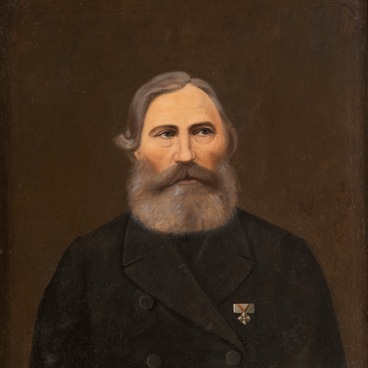The portrait is made in a meagre style with a minimal color palette. The unknown artist limited himself to simple modeling: the clothes are in a single color; light-and-dark color renditions are minimally indicated. The military man is dressed in a dark blue jacket with crimson lapels, yellow buttons, and golden epaulettes without fringes. There are no awards on his uniform. Bychkov’s image is expressly modest, the expression on the face is calm, and he seriously looks at the viewer.
The Bychkovs descended from an ancient noble family included in the genealogical books of Nizhny Novgorod and Vladimir Governorates. Their coat of arms was included in the General Armorial of the Noble Families. Lev Ivanovich — Dmitry Bychkov’s father, was in the Guard Cuirassier Regiment, served as Aide-de-camp of the Headquarters, and retired in the rank of Second Major. Later, he served as associated judge of the Nizhny Novgorod Court of Conscience and Marshal of Nobility of the Murom District. Pelageya Artemyevna — his mother, descended from the noble family of the Yazykovs, who was also elected as Marshals of the Nobility.
Dmitry Bychkov, depicted on the portrait, served in the Horse Regiment of Nizhny Novgorod militia in 1812 — 1816 and in the Lithuanian Lancers regiment in 1816 — 1817. In 1813 and 1815, he participated in the foreign campaign, Magdeburg, and Dresden fortresses siege. Later, he was awarded a bronze medal with St. Vladimir ribbon in the memory of the Crimean War of 1853 — 1856 for his donation to the Vladimir militia.
The researchers suggested that a year after Bychkov’s portrait had been made he left military service. He preferred educational and humanitarian activities much more. The composition of his library indicates that its owner is an educated man: there are history, literature, philology books, and the magazine “Moscow Telegraph”. Bychkov had been this magazine’s subscriber since the magazine’s existence. Certainly, his children were also well educated. According to extant archival documents, Nikolay Dmitryevich, the eldest son of Bychkov, “could read and write in Russian, French, German and Latin, knew general history and arithmetic.”
The exhibited cornet’s portrait was a pair to his wife Varvara Bychkova’s portrait. Both portraits were painted in the “cabinet” genre, which is characterized by the highest possible similarity with the models being portrayed.
The Bychkovs descended from an ancient noble family included in the genealogical books of Nizhny Novgorod and Vladimir Governorates. Their coat of arms was included in the General Armorial of the Noble Families. Lev Ivanovich — Dmitry Bychkov’s father, was in the Guard Cuirassier Regiment, served as Aide-de-camp of the Headquarters, and retired in the rank of Second Major. Later, he served as associated judge of the Nizhny Novgorod Court of Conscience and Marshal of Nobility of the Murom District. Pelageya Artemyevna — his mother, descended from the noble family of the Yazykovs, who was also elected as Marshals of the Nobility.
Dmitry Bychkov, depicted on the portrait, served in the Horse Regiment of Nizhny Novgorod militia in 1812 — 1816 and in the Lithuanian Lancers regiment in 1816 — 1817. In 1813 and 1815, he participated in the foreign campaign, Magdeburg, and Dresden fortresses siege. Later, he was awarded a bronze medal with St. Vladimir ribbon in the memory of the Crimean War of 1853 — 1856 for his donation to the Vladimir militia.
The researchers suggested that a year after Bychkov’s portrait had been made he left military service. He preferred educational and humanitarian activities much more. The composition of his library indicates that its owner is an educated man: there are history, literature, philology books, and the magazine “Moscow Telegraph”. Bychkov had been this magazine’s subscriber since the magazine’s existence. Certainly, his children were also well educated. According to extant archival documents, Nikolay Dmitryevich, the eldest son of Bychkov, “could read and write in Russian, French, German and Latin, knew general history and arithmetic.”
The exhibited cornet’s portrait was a pair to his wife Varvara Bychkova’s portrait. Both portraits were painted in the “cabinet” genre, which is characterized by the highest possible similarity with the models being portrayed.



